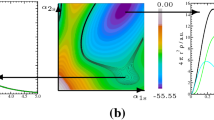Abstract
The replacement of single excitations by orbital transformations in coupled-pair functionals derived from a single double configuration interaction approach is discussed. It is demonstrated that this modification leads to considerably improved density matrices and better agreement with results from coupled cluster singles doubles calculations taken as a reference. A comparison between the variationally optimized orbitals and the Brueckner orbitals shows that these two sets of orbitals are different.


Similar content being viewed by others
References
Langhoff SR, Davidson ER (1974) Int J Quantum Chem 8:61
Davidson ER, Silver DW (1977) Chem Phys Lett 52:403
Bartlett RJ, Shavitt I (1977) Int J Quantum Chem Quantum Chem Symp 11:165
Siegbahn PEM (1978) Chem Phys Lett 55:386
Meissner L (1988) Chem. Phys Lett 146:204
Pople JA, Seeger R, Krishnan R (1977) Int J Quantum Chem Quantum Chem Symp 11: 149
Møller C, Plesset MS (1934) Phys Rev 46:618
Meyer W (1973) J Chem Phys 58:1017
Kelly HP (1964) Phys Rev 134:A1450
Ahlrichs R (1979) Comp Phys Commun 17:31
Kutzelnigg W (1977) In: Methods of electronic structure theory. Schaefer HF III (ed) Plenum Press, New York, pp 129–188
C̆iz̆ek J (1966) J Chem Phys 5:4256
C̆iz̆ek J (1969) Adv Chem Phys 14:35
Bartlett RJ (1981) Annu Rev Phys Chem 32:359
Pople JA, Head-Gordon M, Raghavachari K (1987) J Chem Phys 87:5968
Nesbet RK (1958) Phys Rev 109:1632
Handy NC, Pople JA, Head-Gordon M, Raghavachari K, Trucks GW (1989) Chem Phys Lett 164:185
Pulay P (1983) Int J Quantum Chem Quantum Chem Symp 17:257
Ahlrichs R, Scharf P, Ehrhardt C (1985) J Chem Phys 82:890
Gdanitz RJ, Ahlrichs R (1988) Chem Phys Lett 143:413
Szalay PG, Bartlett RJ (1993) Chem Phys Lett 214:481
Handy NC, Schaefer HF III (1984) J Chem Phys 81:5031
Kollmar C (2006) J Chem Phys 125:084108
Nooijen M, Le Roy RJ (2006) J Mol Struct (Theochem) 768:25
Wennmohs F, Neese F (2008) Chem Phys 343:217
Bak KL, Jørgensen P, Ohlsen J, Helgaker T, Klopper W (2000) J Chem Phys 112:9229
Neese F, Hansen A, Wennmohs F, Grimme S (2008) Acc Chem Res 42:641
Ahlrichs R, Driessler F, Lischka H, Staemmler V, Kutzelnigg W (1975) J Chem Phys 62:1235
Hrušák J, Ten-no S, Iwata S (1997) J Chem Phys 106:7185
Gdanitz RJ (2001) Int J Quantum Chem 85:281
Pulay P, Saebø S, Meyer W (1997) J Chem Phys 81:1901
Hampel C, Peterson KA, Werner HJ (1992) Chem Phys Lett 190:1
Eugene DePrince A III, Mazziotti DA (2007) Phys Rev A 76:042501
DePrince AE III, Mazziotti DA (2007) Phys Rev A 76:042501
Mazziotti DA (2008) Phys Rev Lett 101:253002
Scuseria GE, Schaefer HF III (1987) Chem Phys Lett 142:354
Jørgensen P, Simons J (1981) Second quantization based methods in quantum chemistry. Academic Press, New York, pp 10–13
Levy B (1969) Chem Phys Lett 4:17
Brenig W (1957) Nucl Phys 4:363
Kutzelnigg W, Smith V (1964) The independent-particle model for many–electron systems. I. Comparison of different independent particle model approximations. Preprint No. 130, Quantum Chemistry Group, Uppsala
Sherill CD, Krylov AI, Byrd EFC, Head-Gordon M (1998) J Chem Phys 109:4171
Dykstra CE (1977) Chem Phys Lett 45:466
Köhn A, Olsen J (2005) J Chem Phys 122:084116
Bartlett RJ, Musial M (2007) Rev Mod Phys 79:291
Werner HJ, Knowles PJ, Lindh R, Manby FR, Schütz M et al (2006) Molpro, version 2006.1, a package of ab initio programs. See http://www.molpro.net
Dunning TH Jr (1989) J Chem Phys 90:1007
Ernzerhof M, Marian CM, Peyerimhoff SD (1993) Chem Phys Lett 204:59
Peterson KA, Puzzarini C (2005) Theor Chem Accts 114:283
Huber KP, Herzberg G (1979) Molecular spectra and molecular structure. IV. Constants of diatomic molecules. Van Nostrand Reinhold, New York
Raghavachari K, Trucks GW, Pople JA, Head-Gordon M (1989) J Chem Phys 157:479
Heßelmann A, Jansen G (1999) Chem Phys Lett 315:248
Korona T, Jeziorski B (2006) J Chem Phys 125:184109
Korona T (2006) J Chem Phys 128:224104
Werner HJ, Manby FR, Knowles PJ (2003) J Chem Phys 118:8149
Acknowledgment
C. K. would like to thank F. Neese and H.-J. Werner for stimulating discussions.
Author information
Authors and Affiliations
Corresponding author
Rights and permissions
About this article
Cite this article
Kollmar, C., Heßelmann, A. The role of orbital transformations in coupled-pair functionals. Theor Chem Acc 127, 311–325 (2010). https://doi.org/10.1007/s00214-009-0719-5
Received:
Accepted:
Published:
Issue Date:
DOI: https://doi.org/10.1007/s00214-009-0719-5




